datswite
Ken Ferrari
Here's something I thought I'd share with the group.
Original mast in a 1981 382. I found a very small crack in the masthead sheave box while inspecting the rig for our recent transatlantic. Though possible, it was very difficult to see the crack with the naked eye. In fact, I only noticed it while reviewing the photos we took during the inspection (we performed the inspection via bosun's seat). This crack was located in the lower aft corner of the masthead sheave box, port side. The starboard side was fine, as was the forward side of the mast.
Due to the very small size of the crack, I thought it was pretty inconsequential. However, due to the ramifications of losing a mast 1,000 miles offshore in the North Atlantic, I figured that I should consult with a professional. I hired Brion Toss to take a look, and he was adamant that this was anything but inconsequential. He said that he has seen numerous examples of mastheads being, essentially, ripped from the top of masts. Given the location of the cap shrouds (a few feet below the top of the masthead) and the cut/welds in the corners of the sheave box, he said that this is a built-in design weakness to this type of rig. Not uncommon. He also suggested that once the cracks form, they can progress VERY rapidly. Given this route's reputation of turning into a heavy weather passage, he strongly advised NOT attempting a west-to-east crossing of the Atlantic without addressing the problem - he gave the mast 50:50 odds of surviving the trip if I did nothing to address the issue.
The ultimate fix would be to cut the top of the mast off and replace it with a new masthead - sleeved to the old. That wasn't an option for me given my location (Antigua) and timeline to get moving - we were bumping up against the end of May (hurricane season starts June 1 in the Caribbean). We needed to get moving one way or another - out of the hurricane box. The next best solution would be to drill stop the crack and install a "band-aid" patch in the form a 1/8" stainless steel plate (as large as would fit) riveted transversely across the repair. This is how I addressed the problem.
What you're seeing in the photos is a 1/4" hole drilled at the point of the crack. Brion suggested that it's almost impossible to remove too much material with this method and suggested using this size drill bit. The larger the hole the better - the crack should ideally "see" an infinite radius to minimize the risk of the crack jumping across the drill hole and continuing on the other side.The drill hole is the primary repair - the stainless steel patch is just extra insurance. It was very difficult to get a 1/8" stainless steel plate bent to the proper compound angle/curve to perfectly conform to the mast. Especially given it's location at the top of the mast - sitting in a bosun's seat.
While I have no way of knowing whether or not the mast would have failed without the repair, I'm glad we went through the work to address it. Our passage turned out to be rather challenging. We had wind forward of the beam for 16 of the 18 days it took to get to the Azores, and we had winds in excess of 30 knots or greater for nearly all of the last 7 days (including a total of 25 hours hove-to with wind gust to 48 knots) at sea. We had a 3rd reef in the main for about 1/3 of the entire 2300 mile trip (St. Martin/Azores).
As I mentioned in another thread, this boat is such a joy to sail offshore. She handles rough weather great. She does great in light winds (even loaded down for cruising as we were). Easy to single hand. I estimate that I've put about 15,000 nautical miles (offshore/ocean sailing) on her in the last 4 years of cruising, and she just gets better and better the more I learn about her.
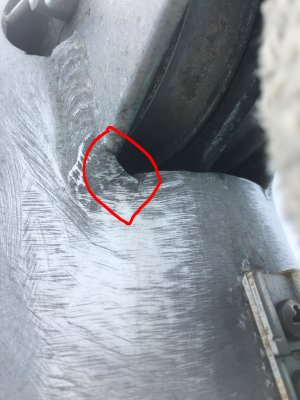
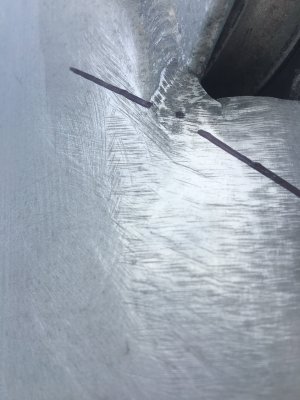
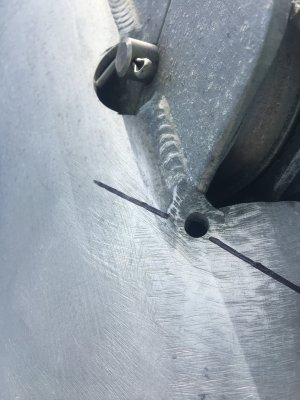
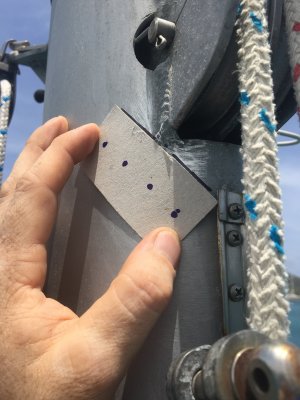
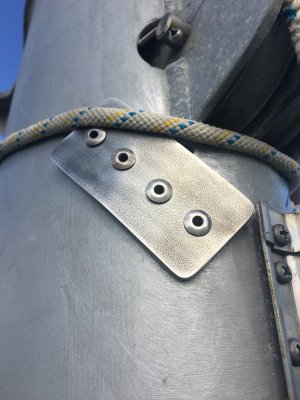
Original mast in a 1981 382. I found a very small crack in the masthead sheave box while inspecting the rig for our recent transatlantic. Though possible, it was very difficult to see the crack with the naked eye. In fact, I only noticed it while reviewing the photos we took during the inspection (we performed the inspection via bosun's seat). This crack was located in the lower aft corner of the masthead sheave box, port side. The starboard side was fine, as was the forward side of the mast.
Due to the very small size of the crack, I thought it was pretty inconsequential. However, due to the ramifications of losing a mast 1,000 miles offshore in the North Atlantic, I figured that I should consult with a professional. I hired Brion Toss to take a look, and he was adamant that this was anything but inconsequential. He said that he has seen numerous examples of mastheads being, essentially, ripped from the top of masts. Given the location of the cap shrouds (a few feet below the top of the masthead) and the cut/welds in the corners of the sheave box, he said that this is a built-in design weakness to this type of rig. Not uncommon. He also suggested that once the cracks form, they can progress VERY rapidly. Given this route's reputation of turning into a heavy weather passage, he strongly advised NOT attempting a west-to-east crossing of the Atlantic without addressing the problem - he gave the mast 50:50 odds of surviving the trip if I did nothing to address the issue.
The ultimate fix would be to cut the top of the mast off and replace it with a new masthead - sleeved to the old. That wasn't an option for me given my location (Antigua) and timeline to get moving - we were bumping up against the end of May (hurricane season starts June 1 in the Caribbean). We needed to get moving one way or another - out of the hurricane box. The next best solution would be to drill stop the crack and install a "band-aid" patch in the form a 1/8" stainless steel plate (as large as would fit) riveted transversely across the repair. This is how I addressed the problem.
What you're seeing in the photos is a 1/4" hole drilled at the point of the crack. Brion suggested that it's almost impossible to remove too much material with this method and suggested using this size drill bit. The larger the hole the better - the crack should ideally "see" an infinite radius to minimize the risk of the crack jumping across the drill hole and continuing on the other side.The drill hole is the primary repair - the stainless steel patch is just extra insurance. It was very difficult to get a 1/8" stainless steel plate bent to the proper compound angle/curve to perfectly conform to the mast. Especially given it's location at the top of the mast - sitting in a bosun's seat.
While I have no way of knowing whether or not the mast would have failed without the repair, I'm glad we went through the work to address it. Our passage turned out to be rather challenging. We had wind forward of the beam for 16 of the 18 days it took to get to the Azores, and we had winds in excess of 30 knots or greater for nearly all of the last 7 days (including a total of 25 hours hove-to with wind gust to 48 knots) at sea. We had a 3rd reef in the main for about 1/3 of the entire 2300 mile trip (St. Martin/Azores).
As I mentioned in another thread, this boat is such a joy to sail offshore. She handles rough weather great. She does great in light winds (even loaded down for cruising as we were). Easy to single hand. I estimate that I've put about 15,000 nautical miles (offshore/ocean sailing) on her in the last 4 years of cruising, and she just gets better and better the more I learn about her.





Last edited:

